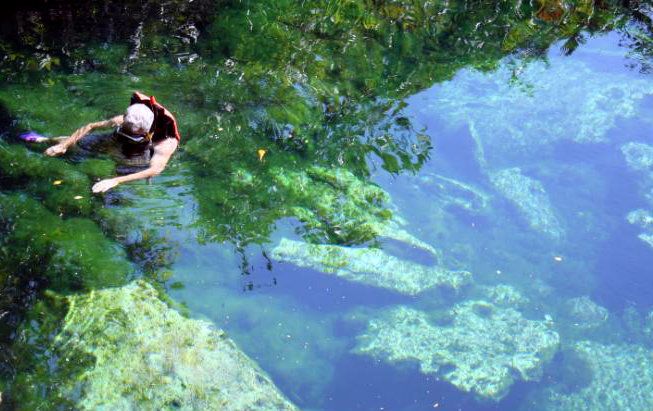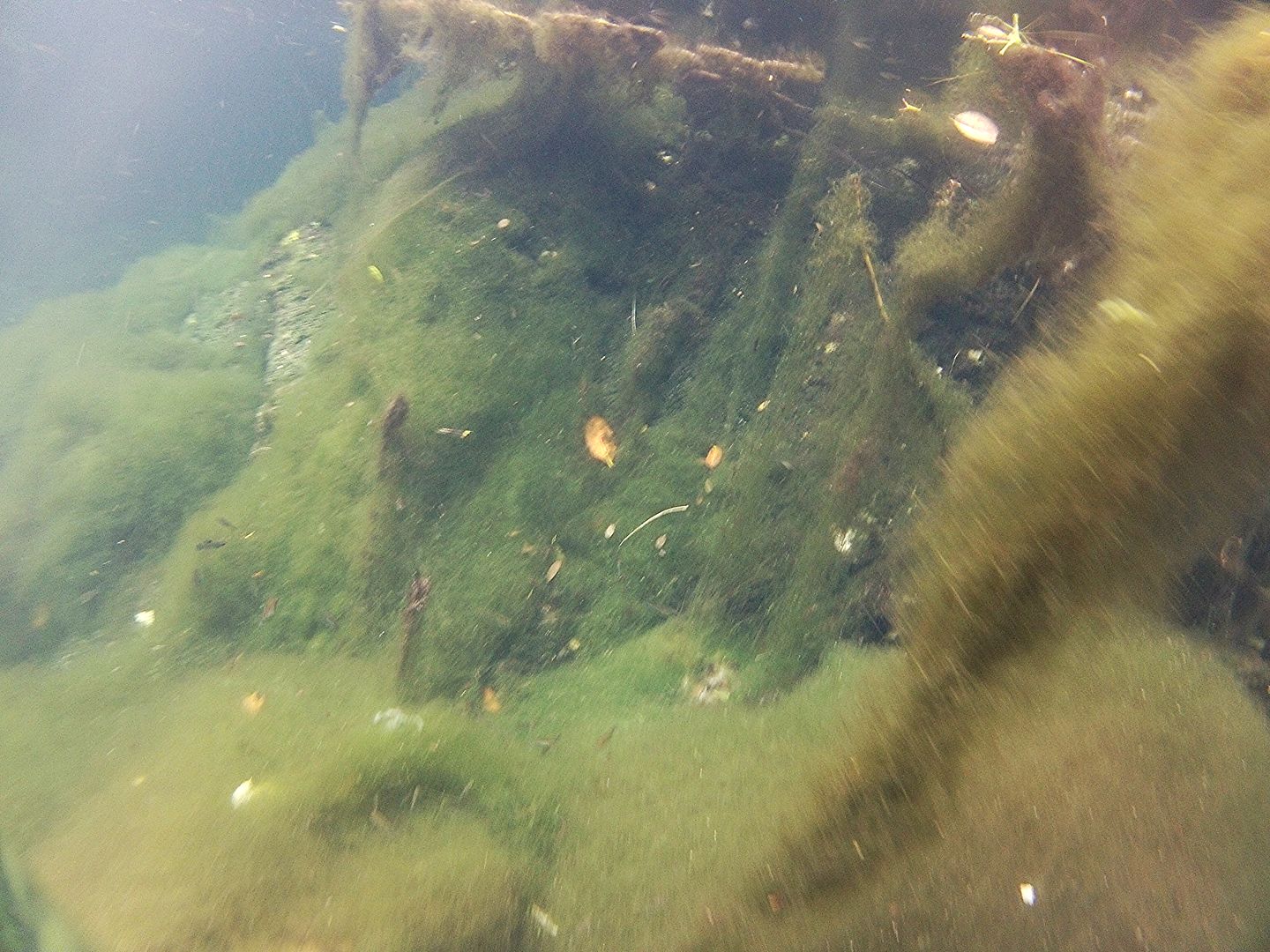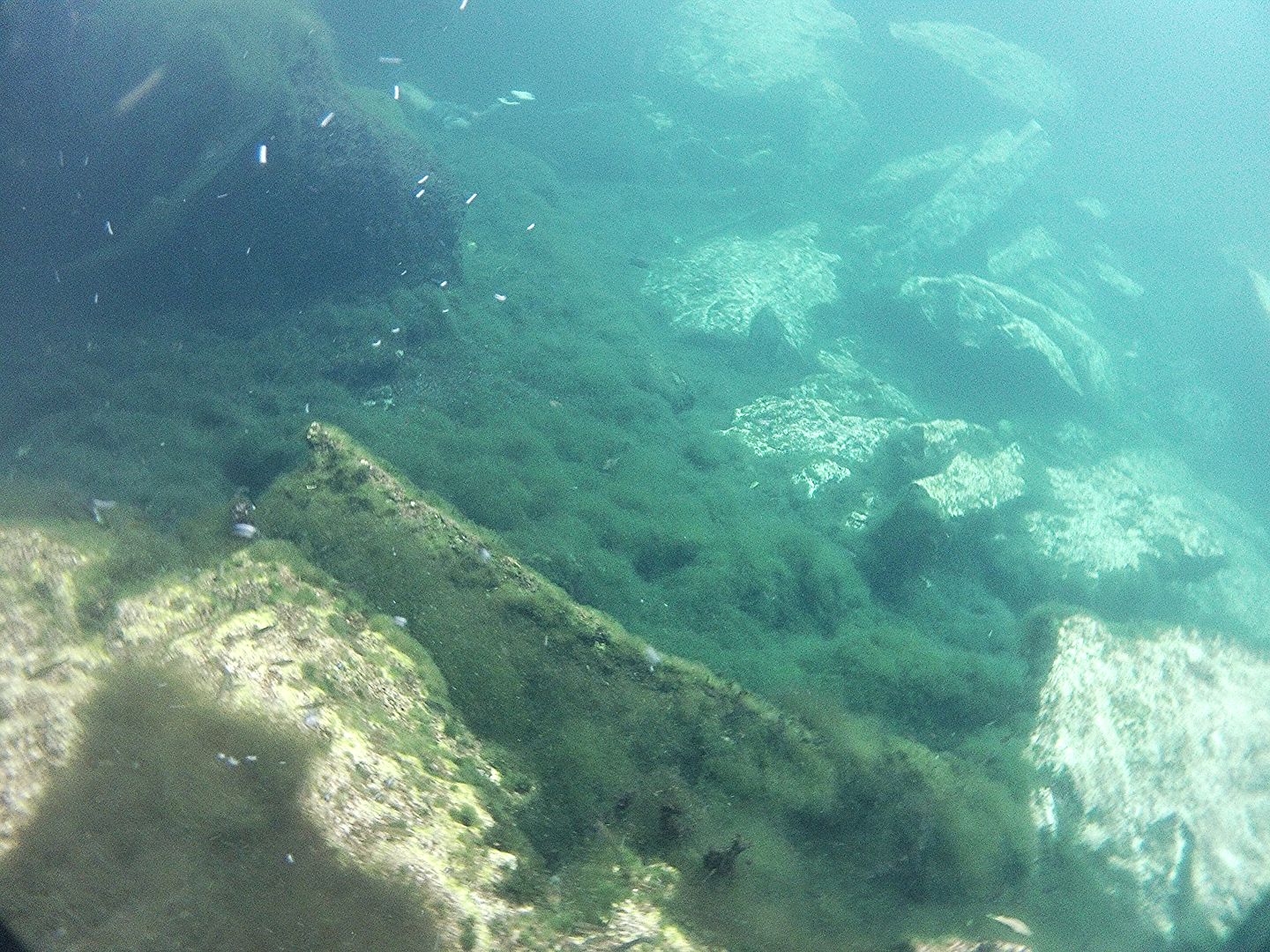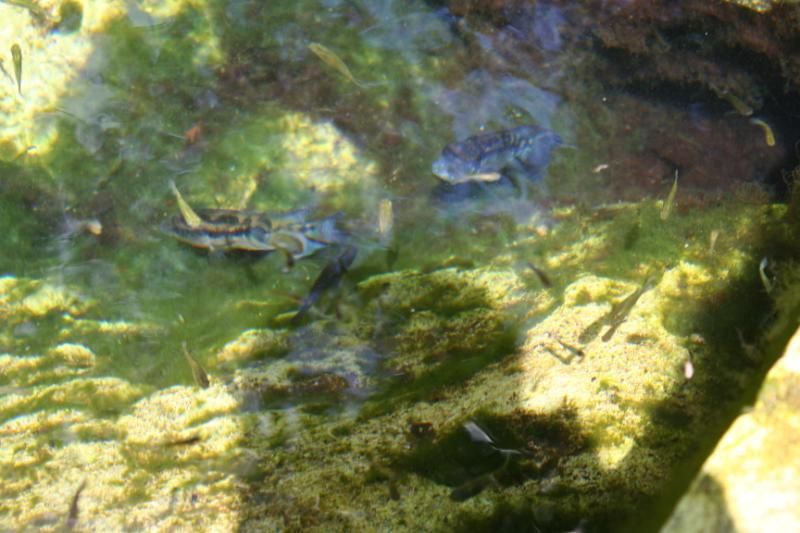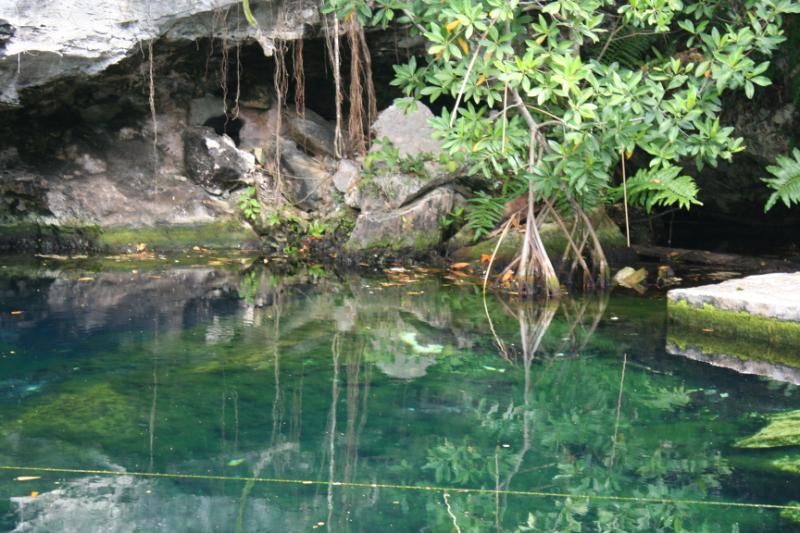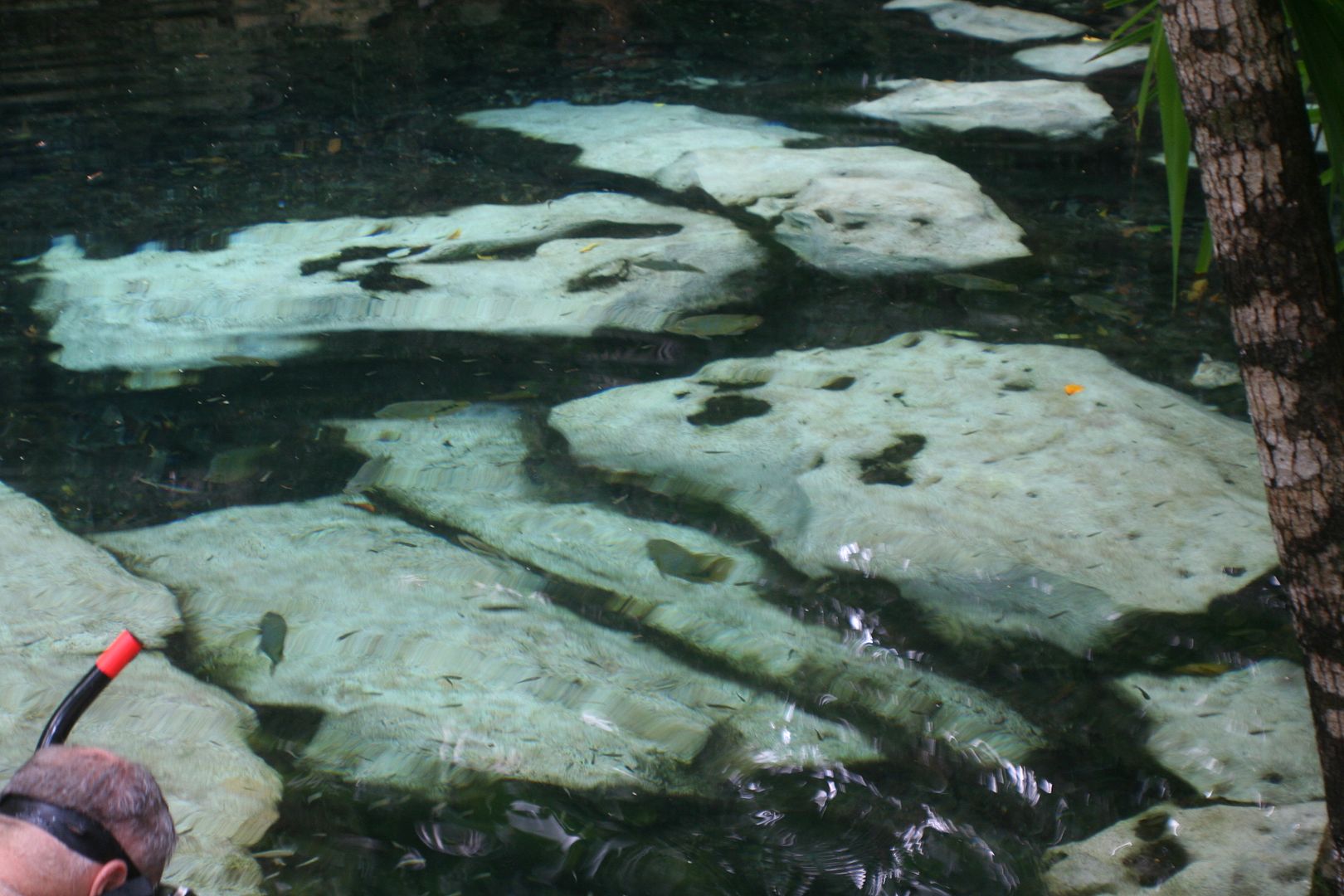Introduction.
I have been asked many times to create a thread, designed to help people gain knowledge, tips and inspiration for setting up natural display tanks for central and south American cichlids.
Although very flattered by the request, I have been somewhat reluctant. My reasons are twofold.
1) There are many great tanks on this sight that easily rival my own.
You can't teach an old dog new tricks.
Those experienced talented aquascapers that already have the knack,may or may not find this thread of much use.
2) My second reason for reluctance has been due to the fact, I feel a little self indulgent creating a thread like this.
I have no problem answering posts when people ask for advice on different topics, this just felt a little self promoting. This is not my intention.
This thread is aimed at cichlid keepers that like to keep their fish in a setting that tries to mimic nature.
I will discuss materials,aesthetics, practical considerations and fish suitability amongst other related topics.
My main aim throughout this thread will be to give people the confidence to push boundaries, experiment and achieve aquascapes that not only the keeper will love,but also the fish love too.
It's time to throw out the colourd gravel,rip out the plastic plants,lose the ornamental skull and if you have a glow in the dark castle.....well shame on you,
It's time to get inspired by nature!
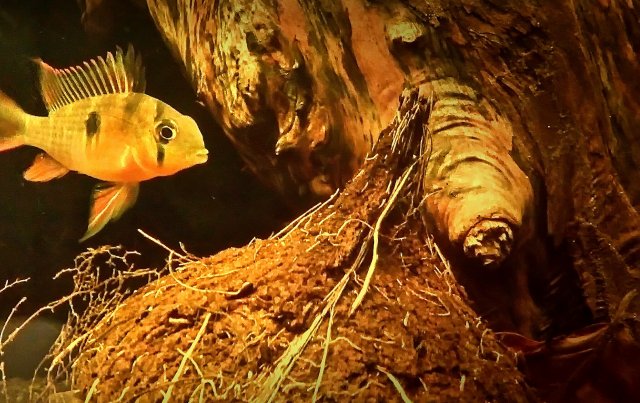
Scale...
Scale, is in my opinion one of the most important and most overlooked aspects of creating a convincing display aquarium for cichlids.
Many factors will contribute to a display not working as a result of being out of scale.
Size of aquarium,size of fish, size of plants and decor can all have a massive influence on the overall look of a display.
Big fish need big tanks. To look right in a natural display setting they need big decor. In nature a lot of cichlids will be swimming past rocks as big as cars.
They will be hiding behind submerged trees not twigs.
There are obviously practical restraints here,heavy rocks and glass are not the greatest partnership.
The secret with big fish is keep it simple. A few carefully positiond rocks will look much more appealing than a detailed design with smaller rocks.
The same does not apply with driftwood. This is where you can become a little more creative. Let your rocks create the structure and scale and let your branches make the display more interesting. This approach is more for central American cichlids than amazonian cichlids,but not exclusively.
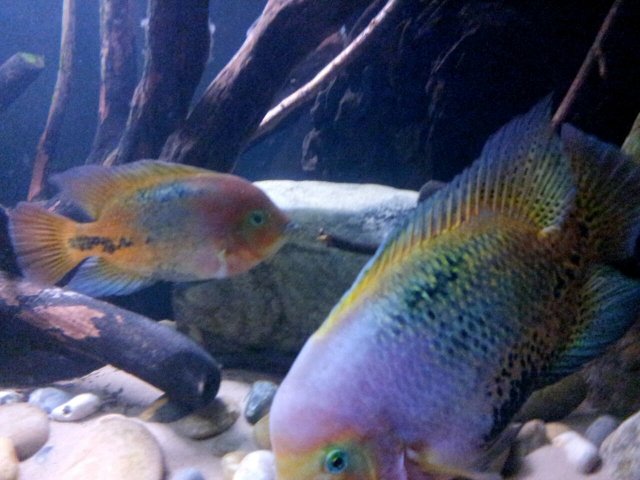
Top to bottom.....
This is something I feel is really worth some consideration.
Use the full height of your aquarium. Sounds quite obvious doesn't it?
I see so many tanks that are let down in appearance by not using the full top to bottom when aquascaping.
Your fish will appreciate line of sight breaks and the extra cover and the display will look a lot better if this is done correctly.

Don't just rely on decor sitting on the substrate,use the whole structure of your tank to aid in giving your display height and interest.
This is especially useful in cichlid community tanks. It will give sub dominant cichlids a means of escape or retreat. It will also provide resting spots for females avoiding relentless pursuits from over eager males.
There are a couple of ways to achieve height in your aquarium.
Use your tanks brace bars.
I use plastic cable ties,like the ones used by electricians.
I use them frequently in nearly every tank I set up.
I attach branches to each other and to the brace bars of my tank. With a little patience and careful placement you can get some very nice effects.


Another method of giving your display height is the use of thin pieces of slate.
I sometimes use aquarium silicone and glue thin branches,standing upright to them. The slate can be buried under the substrate, while the branches reach up to the surface. This is especially useful in tanks with no brace bars.
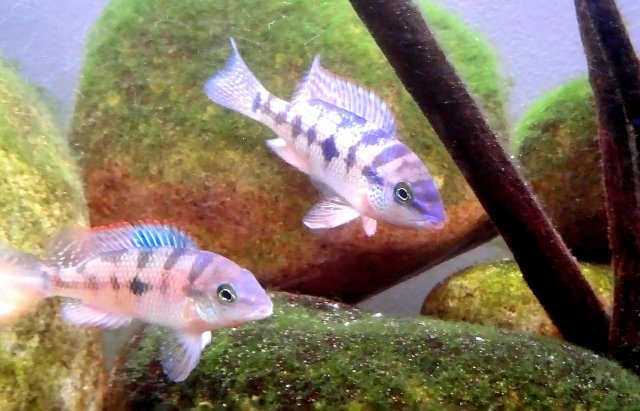
Plants are also useful in creating height in a display tank,especially when they float across the surface.
There are many plant species that are often planted in the substrate that can do equally as well left floating. Hornwart ,Elodea and Brazilian pennywort are just some that can be used left free roaming on the surface.
The tank below has hornwart to help fill a visual gap in the upper levels.

In the tank below I grew moss on branches and let it spread across the surface of the water.
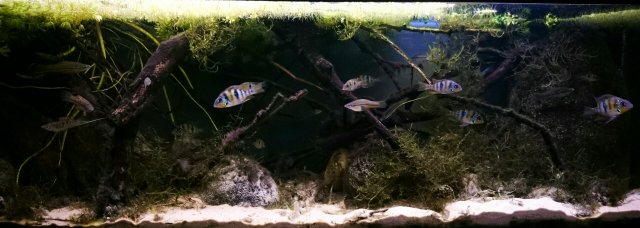
Plants are a useful tool for filling up a bare tank. I never get bogged down with C02 or liquid fertilizers. All my tanks are very low tech.
I choose easy to grow species that will give fast results.
The tiger lotus lily is a good plant that provides great cover for your fish. It's easy and fast growing and provides a beautiful canopy that fish will appreciate. I've used this in c/a tanks to mimic the lily's that are common in Mexican waters.
They should work well with lots of medium sized c/a cichlids.
I used them here in this firemouth display.
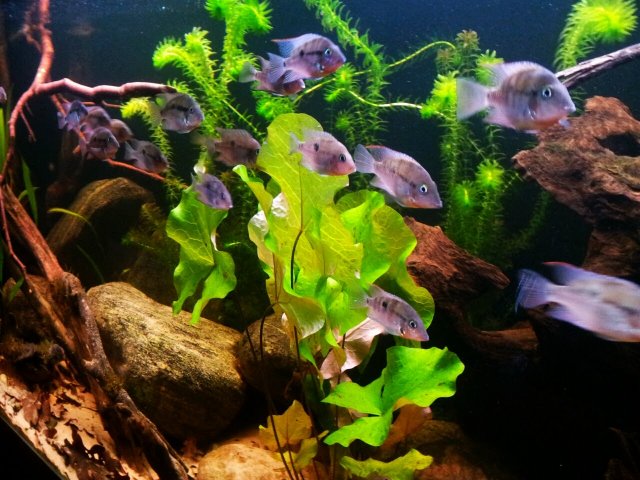
These lily have not yet finished their journey to the surface. Eventually they covered the tank in huge ornate leaves.
One last consideration regarding plants. Just choose 1 or 2 species and use those plants throughout . It will look a lot more natural than lots of different species planted together.
Hide equipment...
Something I never understand is how many people leave heaters and filter pipes etc in full display.
Hide your hardware. Use branches or large plants to completely hide them.
Nothing looks more unnatural than heaters on show. Well,er maybe a world war 2 fighter plane replica lying on the gravel.
Substrate.
Definitely worth talking a little about substrates .
So many available in so many grades and colours.
If you want a natural look avoid coloured gravels and sand. Choose earthy or sandy shades. The majority of natural biotopes I have researched have consisted of sand. To my eyes nothing looks as good as sand.
To make the look more natural and varied add some scatterings of natural gravel of various grades. Bits of twig and some leaf litter can really help make a substrate really look the part .
This tank has a mix of sand,coral sand and gravel.

Leaves....
My obsession of using leaves in fish tanks began about 6 years ago. That obsession is still growing now.
To put it plainly, I absolutely love using leaves in fish tanks. Nothing adds more of a natural feel than the use of leaves.
Both c/a and s/a waters have leaf litter,though we mainly only see them used in amazonian style set ups. I have however seen a slight uprising of their use in c/a tanks over recent years.
Leaves I use are hawthorn, oak,beech,maple,catappa,magnolia and just recently banana leaves.
There are many more leaves that can be used.some release more tannins than others.Oak and catappa and banana leaves seem to add the most tannins. Beech release the least amount of tannins.
I like the tannins in amazon themed tanks but I tend to use beech leaves in c/a tanks where a black water vibe is not intended.
Leaves have many beneficial qualities especially in tanks with fry or certain catfish that will find a food source in the biofilm that is produced as the leaves slowly decompose.
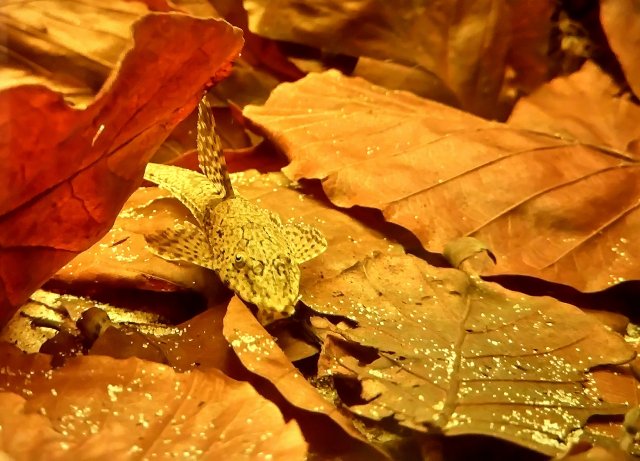
Leaves also help reduce bacterial infections. Some fish importers will add leaves to the bags of some delicate species due to their health benefits.
When collecting leaves care should be taken not to collect leaves that may have been sprayed with insecticides.
I would also advise against collecting leaves from busy roadsides.
Always use fallen leaves and not those collected from trees.
When a leaf falls from a tree it has released its sugars and proteins back into the tree. The leaf then seals itself from the branch and falls.
Due to the fact the leaf has released these sugars and proteins,there is nothing left to add harm to water quality in your tank as they decompose.
In my current set up I have a huge amount of leaf litter. I have no intention of removing these leaves and plan to leave them to decompose and add more as they perish.

Collecting branches....
I always collect my own driftwood. It's free, plentiful and a very effective addition to a natural tank.
The branches must be completely dead have no mould and must come from a suitable type of tree. Most hardwood trees are fine to use.pines,firs and evergreens are generally to be avoided.
Branches I use are oak,beech, hawthorn and fruit trees like apple. As long as they are completely dead,they are safe.
Branches may need to be soaked for a long time before they become waterlogged and sink. Other than this they just need a good clean and they are ready to use.
Don't be shy when using branches and let your imagination and creativity run wild. You may be pleasantly surprised by the results.


Don't fight algea....
I read so many threads about problem algea in tanks. Algea is natural, occurs in the wild and once established can help maintain a healthy environment for the fish.

I let algea cover rocks and branches in most of my tanks. It gives a natural lived in feel to the look off a tank.
I purposely allow a natural influx of sun light on my tanks to help achieve the level of algea required to create a certain look. I know this is not always possible for some situations. Increasing your tanks lighting hours can also give results.

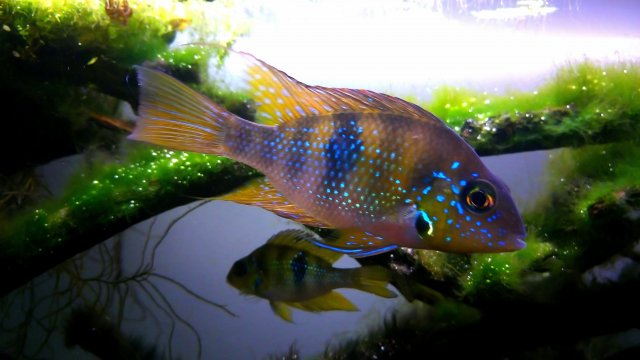
Placement and aesthetics....
Another important part of aquascaping is the actual composition of the tanks decor.
If you have read through all of the information in this thread,you will now have the knowledge of the materials available to decorate your tank.
So how do you place them?
First of all avoid symmetry. Nature is random and wild. This should be reflected in the display. Don't plant in nice neat regimental rows. Nothing should look formal but rather informal.
Don't put rocks or plants in groups of 2 or 4. Always go for 3 or 5. Odd numbers always look more random and natural and is worth keeping in mind.
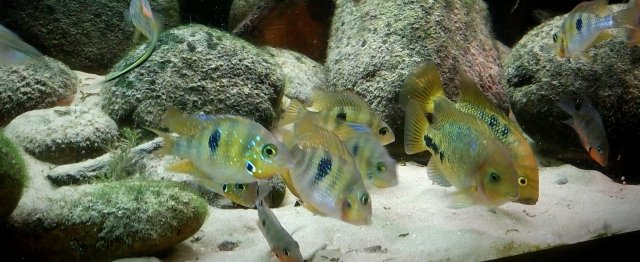
Selecting the fish...
When setting up a tank for a natural feel, the way we stock it can have a make or break impact.
Equally as important as the way we aquascape is the way we stock.
I understand the temptation to buy one each of your favourite cichlid and put them all in together. Showing restraint in this area will normally give a much more natural effect.
Study the cichlids you want to keep and learn how they live in the wild. What fish live with them in the wild? Do they live in pairs? Or groups?
Having the answer to these type of questions will help you stock your tank in a more complimentary and realistic way.
Cichlid tank mates....
Depending on what type of cichlids you keep will have a major impact on the tank mates you keep with them.
Just remember a group of biotope correct compatible characins,livebearers or catfish can give your tank a new aspect of interest.
Don't treat these fish as supporting cast members to your cichlids but as major players in their own right. You may be amazed at the difference they can make to a cichlid biotope.
After thoughts.....
Not everybody is looking at the hobby the same way. We all have different taste,the natural leaf littered look is not for everyone.
Those of you that have the inclination to try,I would encourage you to do so.
Personally I find the whole process very rewarding. From sourcing materials,researching natural habitats and trying to find the right species for the display. It's an educational and satisfying process and an extension into a hobby that's all consuming.
I hope this thread gives some of you some inspiration and hopefully a few newbies can learn something new here.
There are many aspects to this topic,far to many for me to cover them all in this thread.
I hope this thread can prove of some use to those wanting to create a little bit of the natural world in their homes.
I also hope that you can get as much enjoyment out of trying as I do.
Time to get creative.
I have been asked many times to create a thread, designed to help people gain knowledge, tips and inspiration for setting up natural display tanks for central and south American cichlids.
Although very flattered by the request, I have been somewhat reluctant. My reasons are twofold.
1) There are many great tanks on this sight that easily rival my own.
You can't teach an old dog new tricks.
Those experienced talented aquascapers that already have the knack,may or may not find this thread of much use.
2) My second reason for reluctance has been due to the fact, I feel a little self indulgent creating a thread like this.
I have no problem answering posts when people ask for advice on different topics, this just felt a little self promoting. This is not my intention.
This thread is aimed at cichlid keepers that like to keep their fish in a setting that tries to mimic nature.
I will discuss materials,aesthetics, practical considerations and fish suitability amongst other related topics.
My main aim throughout this thread will be to give people the confidence to push boundaries, experiment and achieve aquascapes that not only the keeper will love,but also the fish love too.
It's time to throw out the colourd gravel,rip out the plastic plants,lose the ornamental skull and if you have a glow in the dark castle.....well shame on you,
It's time to get inspired by nature!

Scale...
Scale, is in my opinion one of the most important and most overlooked aspects of creating a convincing display aquarium for cichlids.
Many factors will contribute to a display not working as a result of being out of scale.
Size of aquarium,size of fish, size of plants and decor can all have a massive influence on the overall look of a display.
Big fish need big tanks. To look right in a natural display setting they need big decor. In nature a lot of cichlids will be swimming past rocks as big as cars.
They will be hiding behind submerged trees not twigs.
There are obviously practical restraints here,heavy rocks and glass are not the greatest partnership.
The secret with big fish is keep it simple. A few carefully positiond rocks will look much more appealing than a detailed design with smaller rocks.
The same does not apply with driftwood. This is where you can become a little more creative. Let your rocks create the structure and scale and let your branches make the display more interesting. This approach is more for central American cichlids than amazonian cichlids,but not exclusively.

Top to bottom.....
This is something I feel is really worth some consideration.
Use the full height of your aquarium. Sounds quite obvious doesn't it?
I see so many tanks that are let down in appearance by not using the full top to bottom when aquascaping.
Your fish will appreciate line of sight breaks and the extra cover and the display will look a lot better if this is done correctly.

Don't just rely on decor sitting on the substrate,use the whole structure of your tank to aid in giving your display height and interest.
This is especially useful in cichlid community tanks. It will give sub dominant cichlids a means of escape or retreat. It will also provide resting spots for females avoiding relentless pursuits from over eager males.
There are a couple of ways to achieve height in your aquarium.
Use your tanks brace bars.
I use plastic cable ties,like the ones used by electricians.
I use them frequently in nearly every tank I set up.
I attach branches to each other and to the brace bars of my tank. With a little patience and careful placement you can get some very nice effects.


Another method of giving your display height is the use of thin pieces of slate.
I sometimes use aquarium silicone and glue thin branches,standing upright to them. The slate can be buried under the substrate, while the branches reach up to the surface. This is especially useful in tanks with no brace bars.

Plants are also useful in creating height in a display tank,especially when they float across the surface.
There are many plant species that are often planted in the substrate that can do equally as well left floating. Hornwart ,Elodea and Brazilian pennywort are just some that can be used left free roaming on the surface.
The tank below has hornwart to help fill a visual gap in the upper levels.

In the tank below I grew moss on branches and let it spread across the surface of the water.

Plants are a useful tool for filling up a bare tank. I never get bogged down with C02 or liquid fertilizers. All my tanks are very low tech.
I choose easy to grow species that will give fast results.
The tiger lotus lily is a good plant that provides great cover for your fish. It's easy and fast growing and provides a beautiful canopy that fish will appreciate. I've used this in c/a tanks to mimic the lily's that are common in Mexican waters.
They should work well with lots of medium sized c/a cichlids.
I used them here in this firemouth display.

These lily have not yet finished their journey to the surface. Eventually they covered the tank in huge ornate leaves.
One last consideration regarding plants. Just choose 1 or 2 species and use those plants throughout . It will look a lot more natural than lots of different species planted together.
Hide equipment...
Something I never understand is how many people leave heaters and filter pipes etc in full display.
Hide your hardware. Use branches or large plants to completely hide them.
Nothing looks more unnatural than heaters on show. Well,er maybe a world war 2 fighter plane replica lying on the gravel.
Substrate.
Definitely worth talking a little about substrates .
So many available in so many grades and colours.
If you want a natural look avoid coloured gravels and sand. Choose earthy or sandy shades. The majority of natural biotopes I have researched have consisted of sand. To my eyes nothing looks as good as sand.
To make the look more natural and varied add some scatterings of natural gravel of various grades. Bits of twig and some leaf litter can really help make a substrate really look the part .
This tank has a mix of sand,coral sand and gravel.

Leaves....
My obsession of using leaves in fish tanks began about 6 years ago. That obsession is still growing now.
To put it plainly, I absolutely love using leaves in fish tanks. Nothing adds more of a natural feel than the use of leaves.
Both c/a and s/a waters have leaf litter,though we mainly only see them used in amazonian style set ups. I have however seen a slight uprising of their use in c/a tanks over recent years.
Leaves I use are hawthorn, oak,beech,maple,catappa,magnolia and just recently banana leaves.
There are many more leaves that can be used.some release more tannins than others.Oak and catappa and banana leaves seem to add the most tannins. Beech release the least amount of tannins.
I like the tannins in amazon themed tanks but I tend to use beech leaves in c/a tanks where a black water vibe is not intended.
Leaves have many beneficial qualities especially in tanks with fry or certain catfish that will find a food source in the biofilm that is produced as the leaves slowly decompose.

Leaves also help reduce bacterial infections. Some fish importers will add leaves to the bags of some delicate species due to their health benefits.
When collecting leaves care should be taken not to collect leaves that may have been sprayed with insecticides.
I would also advise against collecting leaves from busy roadsides.
Always use fallen leaves and not those collected from trees.
When a leaf falls from a tree it has released its sugars and proteins back into the tree. The leaf then seals itself from the branch and falls.
Due to the fact the leaf has released these sugars and proteins,there is nothing left to add harm to water quality in your tank as they decompose.
In my current set up I have a huge amount of leaf litter. I have no intention of removing these leaves and plan to leave them to decompose and add more as they perish.

Collecting branches....
I always collect my own driftwood. It's free, plentiful and a very effective addition to a natural tank.
The branches must be completely dead have no mould and must come from a suitable type of tree. Most hardwood trees are fine to use.pines,firs and evergreens are generally to be avoided.
Branches I use are oak,beech, hawthorn and fruit trees like apple. As long as they are completely dead,they are safe.
Branches may need to be soaked for a long time before they become waterlogged and sink. Other than this they just need a good clean and they are ready to use.
Don't be shy when using branches and let your imagination and creativity run wild. You may be pleasantly surprised by the results.



Don't fight algea....
I read so many threads about problem algea in tanks. Algea is natural, occurs in the wild and once established can help maintain a healthy environment for the fish.

I let algea cover rocks and branches in most of my tanks. It gives a natural lived in feel to the look off a tank.
I purposely allow a natural influx of sun light on my tanks to help achieve the level of algea required to create a certain look. I know this is not always possible for some situations. Increasing your tanks lighting hours can also give results.


Placement and aesthetics....
Another important part of aquascaping is the actual composition of the tanks decor.
If you have read through all of the information in this thread,you will now have the knowledge of the materials available to decorate your tank.
So how do you place them?
First of all avoid symmetry. Nature is random and wild. This should be reflected in the display. Don't plant in nice neat regimental rows. Nothing should look formal but rather informal.
Don't put rocks or plants in groups of 2 or 4. Always go for 3 or 5. Odd numbers always look more random and natural and is worth keeping in mind.

Selecting the fish...
When setting up a tank for a natural feel, the way we stock it can have a make or break impact.
Equally as important as the way we aquascape is the way we stock.
I understand the temptation to buy one each of your favourite cichlid and put them all in together. Showing restraint in this area will normally give a much more natural effect.
Study the cichlids you want to keep and learn how they live in the wild. What fish live with them in the wild? Do they live in pairs? Or groups?
Having the answer to these type of questions will help you stock your tank in a more complimentary and realistic way.
Cichlid tank mates....
Depending on what type of cichlids you keep will have a major impact on the tank mates you keep with them.
Just remember a group of biotope correct compatible characins,livebearers or catfish can give your tank a new aspect of interest.
Don't treat these fish as supporting cast members to your cichlids but as major players in their own right. You may be amazed at the difference they can make to a cichlid biotope.
After thoughts.....
Not everybody is looking at the hobby the same way. We all have different taste,the natural leaf littered look is not for everyone.
Those of you that have the inclination to try,I would encourage you to do so.
Personally I find the whole process very rewarding. From sourcing materials,researching natural habitats and trying to find the right species for the display. It's an educational and satisfying process and an extension into a hobby that's all consuming.
I hope this thread gives some of you some inspiration and hopefully a few newbies can learn something new here.
There are many aspects to this topic,far to many for me to cover them all in this thread.
I hope this thread can prove of some use to those wanting to create a little bit of the natural world in their homes.
I also hope that you can get as much enjoyment out of trying as I do.
Time to get creative.



